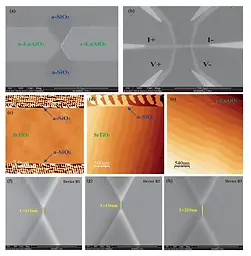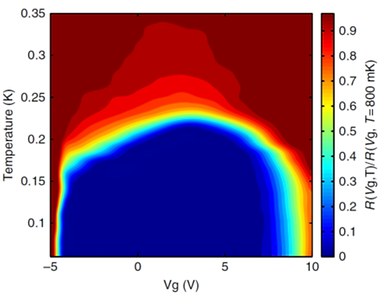Research Highlights
Ferroelectric-superconductor oxide interface

(In collaboration with Beena Kalisky’s group, Bar Ilan)
https://journals.aps.org/prl/pdf/10.1103/PhysRevLett.112.136801
We designed a new interface between a ferroelectric bulk and a polar insulator. The interface is conducting and superconducting. The ferroelectric properties as well as the polar structure affect the conducting and superconducting properties of the interface. Such interfaces can be used as nonmagnetic, superconducting memory devices.
Quantum wire formed at the boundary between two insulating interfaces

https://journals.aps.org/prl/pdf/10.1103/PhysRevLett.112.136801
We designed a boundary between two insulating interfaces that can host one dimensional quantum conductance. The conductance steps indicate that upon increasing gate voltage an electron is added to the system and populates a new quantized mode that adds a conductance precisely e2/h. Surprisingly, spin degeneracy is removed in this wire.
Quantum oscillations from the surface and bulk of doped topological insulators

(In collaboration with Kanigel’s group, Technion)
https://journals.aps.org/prb/abstract/10.1103/PhysRevB.88.195107
and https://journals.aps.org/prb/pdf/10.1103/PhysRevB.86.045131
The frequency of the quantum oscillations is proportional to the area of the Fermi Surface. Using quantum oscillations and ARPES we follow the evolution of the Fermi surface of Cu-doped Bi2Se3. We found that in the superconducting state the Fermi surface opens up making it a candidate for weak 2D topological insulator.
This is in contrast to the surface states where the frequency follows 1/cos(θ) dependence.
Messoscopic devices from oxide interfaces probe the unique electronic ground state of an oxide interface

https://journals.aps.org/prl/pdf/10.1103/PhysRevLett.113.216801
https://journals.aps.org/prb/abstract/10.1103/PhysRevB.82.235119
https://journals.aps.org/prb/abstract/10.1103/PhysRevB.94.045120
We developed a new nanolithography technique to create a quantum dot in the electron liquid. The magnetic field dependence suggests the absence of spin degeneracy in the island.

Controlling superconductivity with light
https://onlinelibrary.wiley.com/doi/full/10.1002/anie.201201606
We put a thin layer, one organic molecule thick, atop a high Tc superconducting film, approximately 50 nanometers thick. When we shined a light on these molecules, the molecules stretched and changed shape, altering their dipole moment. This resulted in a change of carrier density and most importantly, the critical temperature at which the material becomes a superconductor.

Emergent phenomena in correlated oxide interfaces


https://www.nature.com/articles/ncomms9239
We explain both the normal state transport properties: nonmonotonic dependence of the quantum oscillation frequency and Hall coefficient and the superconducting dome using a strong correlation model.
https://journals.aps.org/prl/abstract/10.1103/PhysRevLett.104.126802
The strong Rashba type spin-orbit interaction plays a major role in the normal state and supercondcucting properties of the LaAlO3/SrTiO3 interface. These findings are very important for spin-transport applications and for basic understanding of the transport and superconducting properties of this interface.
https://journals.aps.org/prl/abstract/10.1103/PhysRevLett.105.206401
We made high-mobility samples enabling us to observe Shubnikov-de Haas oscillations originating from the 2D interface. We gave the first indication for the existence of multiple bands contributing to the conductivity
Hole superconductivity near a quantum critical point in electron-doped cuprates

https://journals.aps.org/prb/abstract/10.1103/PhysRevB.82.094508
https://journals.aps.org/prb/abstract/10.1103/PhysRevB.76.024506

Multiple ground states of TaS2 polytypes
Signatures of Quantum Spin Liquid in 1T-TaS2
https://journals.aps.org/prb/abstract/10.1103/PhysRevB.96.195131
(Collaboration with the Kanigel’s group, Technion)
Chiral Superconductivity in 4Hb-TaS2
https://advances.sciencemag.org/content/6/13/eaax9480
The superconducting state of 4Hb-TaS2 is consistent with a chiral superconductor with a very strong spin-orbit interaction


View Gallery













